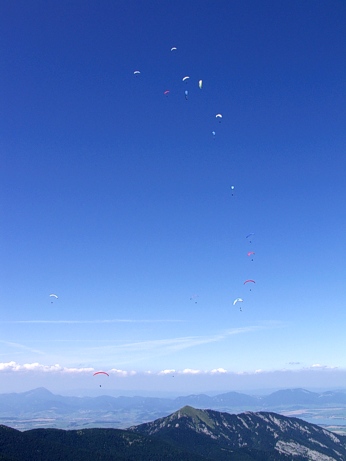Thermal Lore
Develop a mental picture of what a thermal looks like. Thermals are rarely exactly like the textbook pictures. Watch some smoke rising from an industrial smokestack, or fast motion film of clouds to visualise the dynamic and somewhat chaotic movement of rising air. Thermals range from short lived bubbles to columns extending from the ground to cloudbase. They may be weak or strong. Some are wide, some narrow, some elongated downwind. Add to your picture with experience.
As you approach a thermal you can expect to find quite strong sink. You often run into alternating short 1-2 second surges of lift and sink as you get closer. Next you will encounter lift.
In almost all thermals there is at least one and often several strong cores of rapidly rising air surrounded by areas of more moderate lift.
To find the core you must first look for it !
Too many pilots are simply satisfied to be in lift and contentedly circle in 200 up when there is 800 up to be had nearby.
When you enter a thermal you should not stop and circle at the first indication of lift (unless very low, thermals small, etc). Instead continue flying into the thermal. Sometimes a wing may be lifted as the strongly rising air in a core tries to push you away. Do not let this happen! Turn towards the lifted wing to be rewarded with the stronger lift. Alternatively the lift may peak and then drop off without any wing lift if you fly straight through a core. As soon as the lift drops off crank a turn.
Once you have found a core that's not the end. Expect to make minor bank adjustments every circle to stay centred and often major adjustments every 10 circles to stay in the best lift. Soaring birds rarely circle in neat circles as they search out the best lift, neither should you.
If you have been circling in a core and then lose it you should have a plan. The best one is to first look upwind first as you generally fall out the downwind side (see books for explanation). Next look downwind. Finally look crosswind. If there is no sign of the thermal after this search move on, thermals can and do have bottoms that you can fall through but unfortunately searching up is not an option!
Clover leaf search pattern
Develop a clover leaf search pattern to explore thermals.
|

Starting from a circle in lift explore the four imaginary quadrants of the clover leaf one at a time. You do this by extending your circles sequentially into each quadrant. After each extension come back to the centre if better lift is not found before going on to explore the next quadrant. In this way you keep track of known lift while continually looking for better lift.
Generally speaking at low altitudes thermals tend to narrower and more bubble like. Tip - never leave lift low! At intermediate altitudes thermals become wider and strong cores are often present. Towards the top of a thermal lift often drops of while the thermal continues to get wider. Often strong lift may be encountered near cloudbase (cloudsuck). At the beginning of the day bubbles predominate. "Classic thermals" occur during the peak of the day which depends on location but as a rule peak ground heating (and hence thermal strength) is around 2.30pm LOCAL SUN TIME. Towards evening smooth, wide weaker thermals are the norm. Turbulence is generally worst during the peak of the day and often near cloudbase.
|